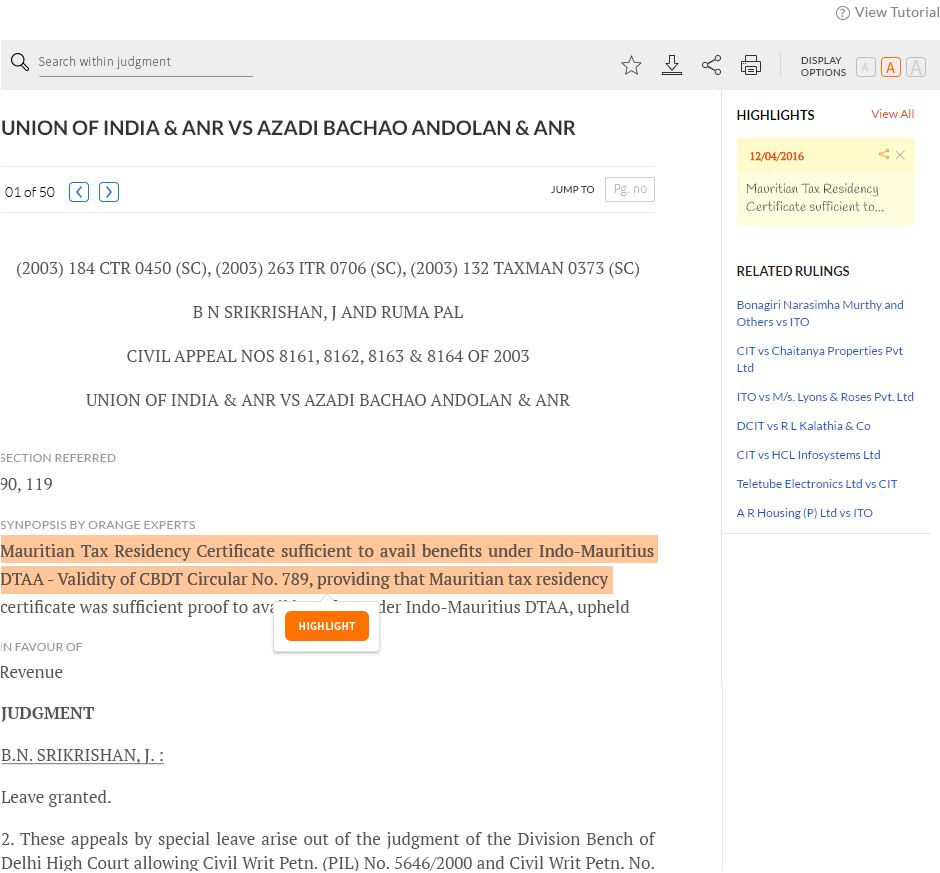
-
2025-08-01
Before diving into the implications of the proposed amendments to the definition of Associated Enterprises (“AEs”) under the Income Tax Bill, 2025 (‘Bill’), it is essential to first revisit the current legal framework under Section 92A of the Income-tax Act, 1961.
Where We Stand Today: The Current Legal Framework in Section 92A
Under the existing Income-tax Act, 1961, the definition of an AE is found in Section 92A, which consists of two parts:
- Section 92A(1) articulates the general rule, emphasizing control or participation in the management, control, or capital of an enterprise.
- Section 92A(2) enumerates thirteen specific conditions—including substantial shareholding, loans, guarantees, or economic dependence—that inform the determination of AE relationships.
Following the 2002 amendment, the opening phrase of Section 92A(2) was changed to:
“For the purposes of sub-section (1), two enterprises shall be deemed to be associated enterprises…”
This change explicitly linked the two subsections, indicating that Section 92A(2) serves to clarify and operationalize Section 92A(1) i.e., required to be read conjunctively. The clarification provided in the Memorandum to the Budget 2002 also clarifies the intent behind the amendment, covering parties as AEs only where the criteria fulfilled in sub-section (2) are fulfilled.
Historically, tax authorities sometimes treated these subsections as independent—meaning that even if only one of them was satisfied, the relationship could be deemed an AE. However, judicial interpretation, including a key High Court ruling later upheld by the Supreme Court, clarified that both subsections must be read together for a valid AE determination.
The Gujarat High Court ruling in the case of Veer Gems, [TS-545-HC-2017(GUJ)-TP] which was later upheld by the Supreme Court of India, Pr. CIT v. Veer Gems, Special Leave Petition (Civil) Diary No. 37719/2017, decided on January 5, 2018- [TS-2-SC-2018-TP]
• Issue: Whether mere participation in the management, control, or capital (as per Section 92A(1)) is sufficient to establish an AE relationship, or would it require a specific condition of Section 92A(2) to be fulfilled?
• Ruling: The Income-tax Appellate Tribunal (ITAT) and later the High Court held that both Section 92A(1) and 92A(2) must be read together.
• Impact: This clarified that subsection (1) provides the general definition, but subsection (2) lists specific conditions that must also be met. Even if one of the specific conditions in Section 92A(2) is met, the basic test under Section 92A(1) must also be satisfied for entities to be considered AEs.
Understanding the Shift: From Section 92A to Section 162
The Income-tax Bill, 2025 was introduced in Parliament in February 2025. The Bill defines AEs under Section 162, with a specific change replacing the phrase “for the purposes of sub-section (1)” with “without affecting the generality of the provisions of sub-section (1)” in the new version of what corresponds to Section 92A(2).
This seemingly subtle shift has major implications. It suggests that the two parts—formerly interpreted conjunctively—can now be read independently. In essence, the amendment could override the settled judicial position and allow either test to trigger AE status on its own.
Concerns from the Select Committee
The Income-tax Bill, 2025 was subsequently referred to a Select Committee for detailed review. Given the Bill’s scale and potential impact, the Committee undertook extensive stakeholder consultations, invited public feedback, conducted oral hearings, and held regional discussions before releasing its report and a revised draft in July 2025.
The Select Committee, after reviewing the draft Bill, expressed reservations about the proposed change. While the Bill’s objective is to streamline the tax code, the Committee cautioned that the expanded definition of Associated Enterprises could introduce new layers of ambiguity. To preserve alignment with established judicial interpretations and the framework of the 1961 Act, it recommended reverting to the original language.
Despite these recommendations, the latest draft of the Bill proposes a blended version of the AE definition that merges the general principles with the specific conditions into a single expanded definition. This version appears to significantly widen the net for what constitutes an AE.
Broader Impact: More Entities Could Now Be Caught in the Net
This revised AE definition could rope in many more transactions into the transfer pricing regime. Even where there is no clear management control or equity holding, companies could still be considered AEs based on vague indicators like "participation" in the management—without any objective thresholds.
This opens the door to:
- Subjective assessments by tax officers,
- Increased compliance burden for taxpayers, and
- A renewed wave of litigation—ironically, the very outcome the Bill aimed to avoid.
The amendment also raises concerns about inconsistencies with other laws governing related party transactions, such as the Companies Act and SEBI regulations. With each framework using different definitions, taxpayers may face confusion and added compliance challenges. Navigating these differing requirements could become difficult, leading to uncertainty about how these rules align or interact.
Here are a few illustrative scenarios that highlight the potential reach of the new AE definition:
1. Collaborative R&D – Pharma or Tech Sector
Scenario: An Indian biotech firm collaborates with a foreign entity on drug development. The foreign partner:
• Funds part of the research,
• Has access to proprietary data,
• Influences project milestones without direct operational control.
AE Risk: Despite no equity stake or formal control, the collaboration may be viewed as “economic dependence,” potentially triggering AE classification under the expanded definition.
2. Education and Tech Partnerships
Scenario: An Indian edtech startup partners with several foreign universities to deliver online courses. The universities typically:
- Provide curriculum and faculty,
- Share revenue,
- Influence platform design.
AE Risk: Shared decision-making and financial interdependence could be interpreted as “participation” in management, making these partnerships vulnerable to AE classification.
3. Digital Platform Alliances
Scenario: A global SaaS provider integrates its tools into an Indian startup’s platform. The foreign company:
• Offers discounted pricing,
• Has access to user analytics,
• Co-brands the service.
AE Risk: These arrangements could be interpreted as indirect control or influence, especially if the startup relies heavily on the foreign partner’s tech and branding.
Final Thoughts
The proposed changes to the AE test are far from straightforward. By disrupting the clarity provided by courts and expanding the definition without adequate safeguards, the draft law risks complicating the very system it seeks to streamline. As global tax frameworks evolve, the redefinition of AEs in India may signal a broader shift toward more expansive interpretations of economic relationships. Could this trend influence international norms on transfer pricing and related party transactions? Will businesses need to rethink their collaboration models, strategic alliances, and supply chain dependencies to avoid unintended tax consequences?
It’s important to recognize that India’s existing AE definition was already among the more comprehensive globally—often seen as more detailed than those in many other jurisdictions. The proposed broadening, while aiming to capture modern business realities, may risk stretching the definition further than necessary, potentially creating uncertainty for taxpayers.
Although the amendment was likely intended to streamline the AE determination process, it seems to have had the opposite effect—introducing greater complexity, legal uncertainty, and the risk of increased disputes.
Businesses, advisors, and policymakers must engage in constructive dialogue to ensure that the final version of the Bill offers both clarity and consistency.


